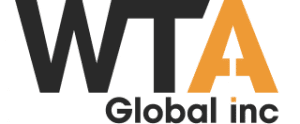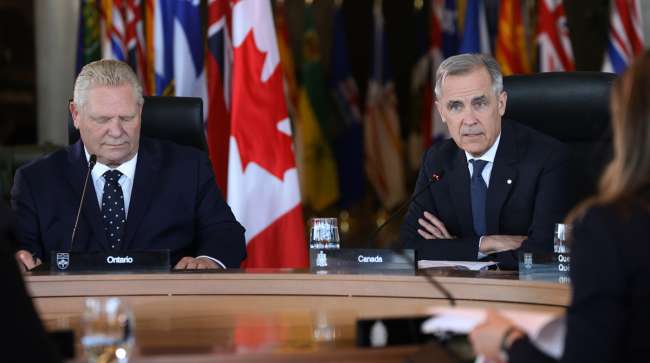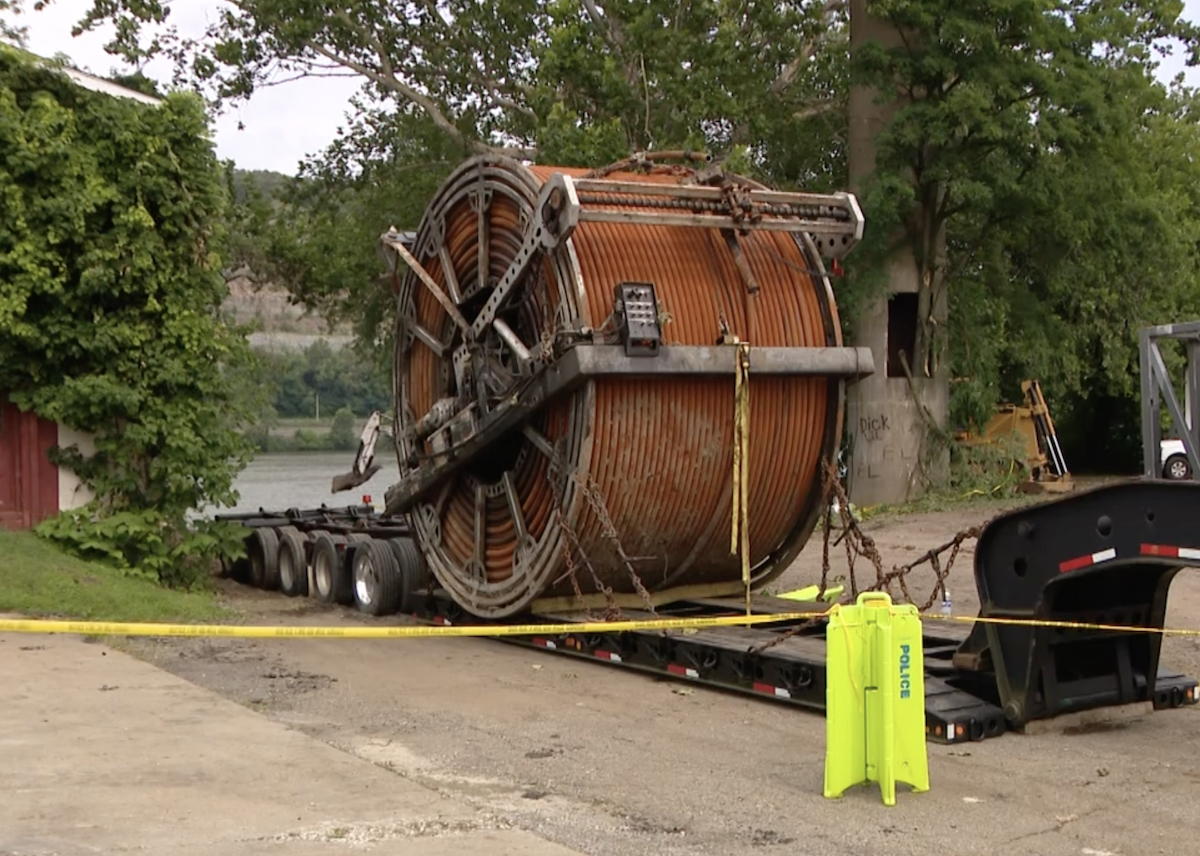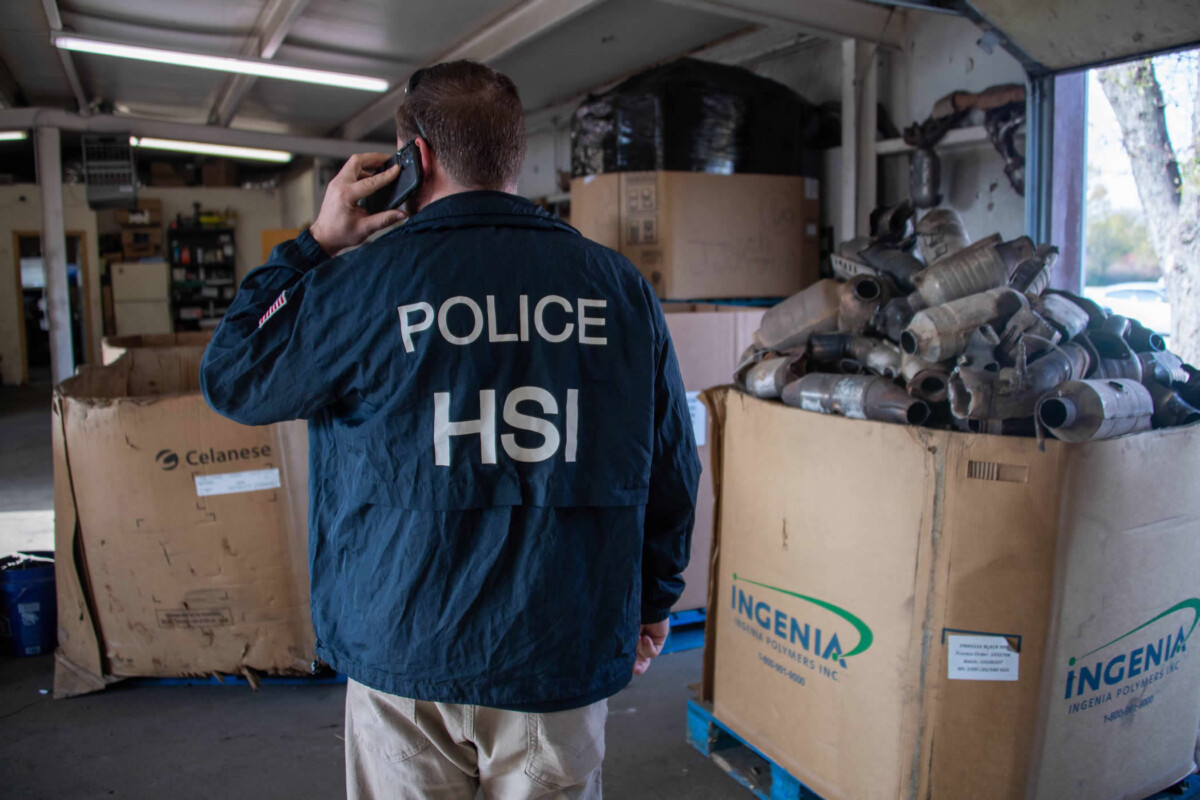Ontario Premier Doug Ford with Carney. (David Kawai/Bloomberg)
Prime Minister Mark Carney is pushing to offset the economic pain caused by U.S. President Donald Trump’s tariffs by compelling Canadian provinces to liberalize trade with one another.
Trump’s erratic policy announcements have sent Canadian companies scrambling to find new buyers, as economists see exports declining sharply in the middle of this year. And as the country eyes stronger ties with Europe and Asia, it’s first taking a hard look at its own inefficient trade barriers.
Carney will meet June 2 with provincial and territorial premiers to accelerate efforts to lower trade barriers between them. Various studies see freer internal trade growing the size of the economy by between 0.5% and 8%, with the government typically touting the higher end of those estimates.
He has also asked the premiers to offer suggestions for big “nation-building” projects they would like to see built, with the goal of identifying several that can be fast-tracked. Pipelines, critical minerals projects and trade corridors are at the top of the premiers’ lists.
“We can give ourselves far more than they can take away,” Carney said of the U.S. during the April election campaign. His pledge to win the trade war and make Canada’s economy the strongest in the Group of Seven helped propel his Liberal Party to victory — but now he needs to accomplish his goals.

(Bloomberg)
In 2023, half of Canadian businesses said they neither purchased nor sold goods in other provinces. While some products face outright restrictions, such as alcohol, other barriers to trade include differing regulatory and technical standards for everything from food safety to transportation to professional accreditation.
Various governments have promised to free up internal trade, only to find that lifting those roadblocks is far more difficult than imagined. Provinces have a fair degree of authority under Canada’s constitution to regulate many types of businesses, and some provincial rules — such as Quebec’s French labeling laws — reflect the political will of their residents and are unlikely to be scrapped.
In 2017, all provinces and territories and the federal government signed the Canadian Free Trade Agreement. The deal aimed to cut down on obstacles to business, but exemptions were granted for every jurisdiction. British Columbia, for example, retains strict control of timber harvested from provincial land, while Prince Edward Island has broad authority over fishery licensing.
In April, Ontario became the first province to announce it was removing all its exemptions. The federal government has also begun eliminating its exemptions, and Carney has promised legislation to axe the rest by July 1.
Getting all the provinces to drop their barriers is the tougher part. Existing restrictions have codified market power for some producers, limiting the competition they face across the country. But Trump’s tariffs and his 51st state rhetoric have proven a motivator for many provinces — Ontario has inked new trade agreements with Manitoba, Nova Scotia, Alberta and other provinces in recent months.
Carney’s push to speed up project approvals, with the overall goal of turning Canada into an “energy superpower,” is also likely to face hurdles. Assembly of First Nations National Chief Cindy Woodhouse Nepinak told the Canadian Press some Indigenous leaders feel “disrespected,” and if they aren’t included in decision-making now, the government will face more problems later.

Bottles of local wine at a Liquor Control Board of Ontario store in Toronto. (Christopher Katsarov Luna/Bloomberg)
Alcohol Trade
While economists disagree about how much growth the country can unlock by freeing internal trade, there’s consensus among most, including the central bank, that it would boost potential economic activity, reduce inflationary pressures, and help Canada’s productivity. It would be an undeniable boon, said John McNally, a senior policy adviser with Bank of Nova Scotia.
Companies and provincial governments need to ask themselves if they’re “willing to make the investments and the changes to help unlock this, to improve Canada’s overall resilience and also to help connect to different markets both within the country and overseas,” McNally said in an interview.
“You could end up seeing some of those firms be adversely impacted, but it’s also enormously likely that those firms also get the same access to other markets that other firms get.”
Refocusing commercial flows between east and west after decades of ever-tighter reliance on north-south trade would also mark a reassertion of the northern nation’s sovereignty — a direct reaction to Trump.
Trade in goods and services between provinces and territories totaled C$532 billion ($387 billion) in 2023, representing 18% of Canada’s gross domestic product, according to Statistics Canada. That compares to C$978 billion in exports abroad.

(Bloomberg)
Imports were the equivalent of nearly 34% of Canada’s GDP in 2023, compared with 14% in the U.S. About half of Canada’s goods imports are from the U.S., Statistics Canada data show. Meanwhile, about three-quarters of its goods exports head to its southern neighbor.
Aaron Dobbin, CEO of Wine Growers Ontario, which represents firms responsible for about 80% of the wine produced in Canada’s largest province, said his members expect to benefit from freer internal trade.
Alcohol sales between provinces are limited, partly because governments have sought to protect local producers from outside competition. Most wineries, breweries and distilleries can’t ship directly to consumers in other parts of the country. While Dobbin acknowledged Ontario wineries will face more competitors, he said his members — especially the smaller ones — see broader market gains.
“We view this as a great opportunity to introduce Canadians to the great Ontario wines and to develop a new solid customer base across the country,” Dobbin said in an interview.
“I have very clear marching orders that this is something we want to see happen.”






